Brand Management Report: Strategies for M&S (MARKETING 17)
VerifiedAdded on 2022/11/17
|18
|4027
|212
Report
AI Summary
This report provides a comprehensive analysis of brand management strategies, focusing on the case of Marks & Spencer (M&S). It begins by highlighting the importance of branding for organizations, discussing how branding promotes recognition, differentiates from competition, motivates staff, generates referrals, connects with customers emotionally, and provides business value. The report then delves into how organizations can grow and develop brand equity, outlining the steps involved in building brand identity, creating meaning, shaping customer perceptions, and fostering customer relationships. Subsequently, the report examines how M&S can extend, reinforce, and revitalize its brand, offering suggestions such as initiating a new purpose in clothing, cherishing core shoppers, listening to customers, making data-driven decisions, and focusing on long-term brand revival. The report then explores brand portfolio and hierarchy management, differentiating between house of brands, branded house, and hybrid house structures, with examples. It also defines brand leverage and evaluates the strengths and weaknesses of the M&S brand, offering options for collaboration and partnerships to help grow the M&S brand. Finally, the report discusses the measurement and management of brand value, including brand awareness, consumer attitudes, and purchasing intent.
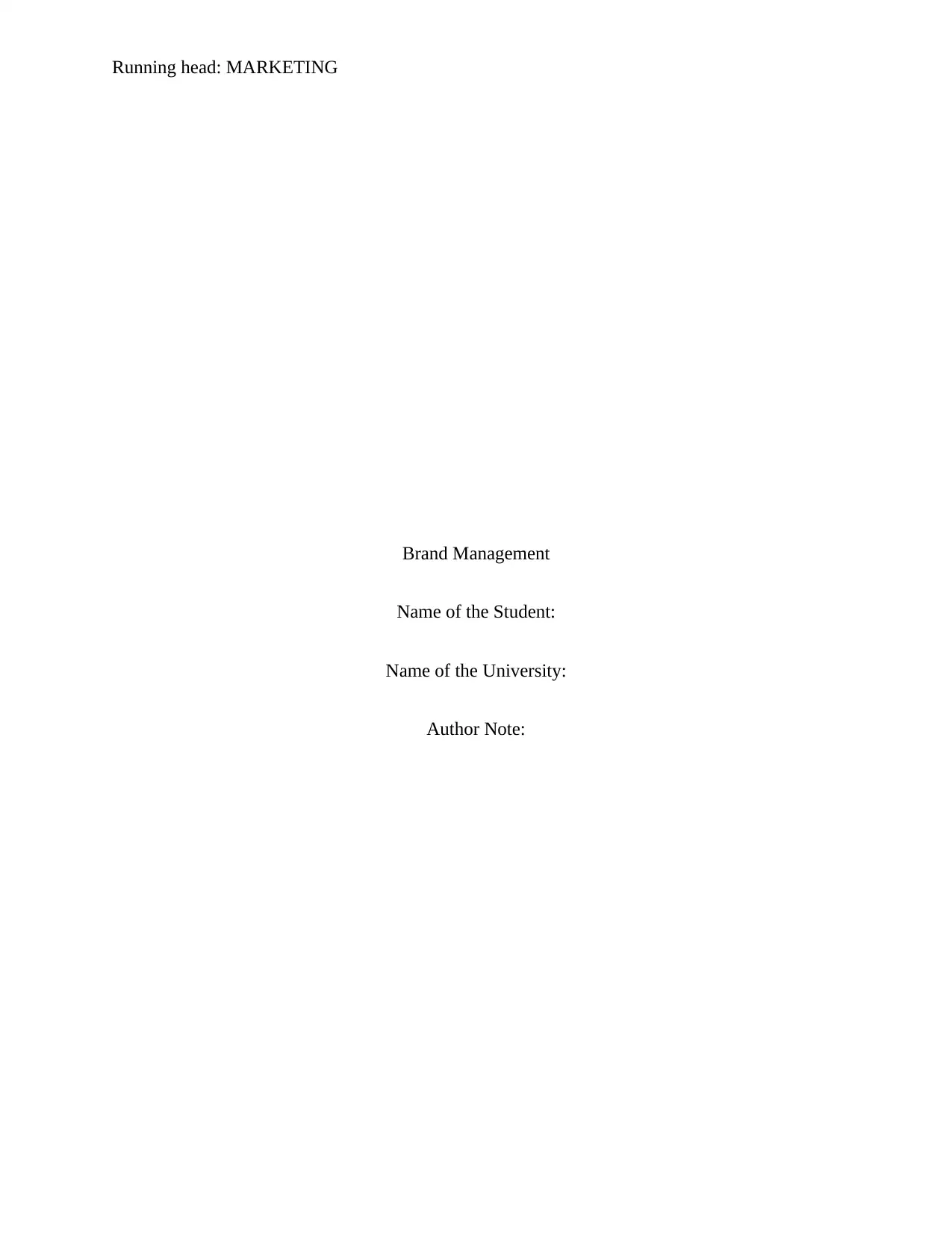
Running head: MARKETING
Brand Management
Name of the Student:
Name of the University:
Author Note:
Brand Management
Name of the Student:
Name of the University:
Author Note:
Paraphrase This Document
Need a fresh take? Get an instant paraphrase of this document with our AI Paraphraser
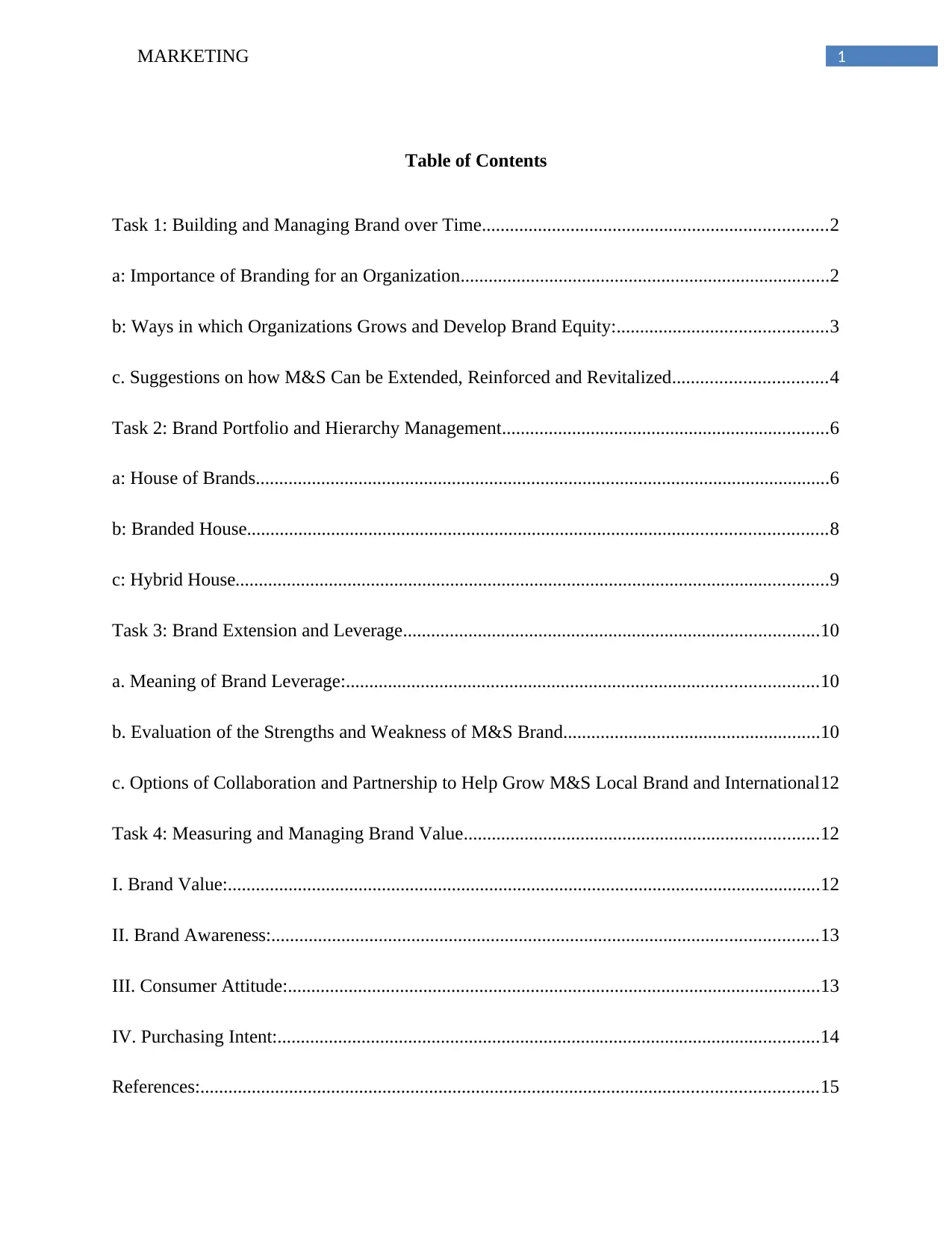
1MARKETING
Table of Contents
Task 1: Building and Managing Brand over Time..........................................................................2
a: Importance of Branding for an Organization...............................................................................2
b: Ways in which Organizations Grows and Develop Brand Equity:.............................................3
c. Suggestions on how M&S Can be Extended, Reinforced and Revitalized.................................4
Task 2: Brand Portfolio and Hierarchy Management......................................................................6
a: House of Brands...........................................................................................................................6
b: Branded House............................................................................................................................8
c: Hybrid House...............................................................................................................................9
Task 3: Brand Extension and Leverage.........................................................................................10
a. Meaning of Brand Leverage:.....................................................................................................10
b. Evaluation of the Strengths and Weakness of M&S Brand.......................................................10
c. Options of Collaboration and Partnership to Help Grow M&S Local Brand and International12
Task 4: Measuring and Managing Brand Value............................................................................12
I. Brand Value:...............................................................................................................................12
II. Brand Awareness:.....................................................................................................................13
III. Consumer Attitude:..................................................................................................................13
IV. Purchasing Intent:....................................................................................................................14
References:....................................................................................................................................15
Table of Contents
Task 1: Building and Managing Brand over Time..........................................................................2
a: Importance of Branding for an Organization...............................................................................2
b: Ways in which Organizations Grows and Develop Brand Equity:.............................................3
c. Suggestions on how M&S Can be Extended, Reinforced and Revitalized.................................4
Task 2: Brand Portfolio and Hierarchy Management......................................................................6
a: House of Brands...........................................................................................................................6
b: Branded House............................................................................................................................8
c: Hybrid House...............................................................................................................................9
Task 3: Brand Extension and Leverage.........................................................................................10
a. Meaning of Brand Leverage:.....................................................................................................10
b. Evaluation of the Strengths and Weakness of M&S Brand.......................................................10
c. Options of Collaboration and Partnership to Help Grow M&S Local Brand and International12
Task 4: Measuring and Managing Brand Value............................................................................12
I. Brand Value:...............................................................................................................................12
II. Brand Awareness:.....................................................................................................................13
III. Consumer Attitude:..................................................................................................................13
IV. Purchasing Intent:....................................................................................................................14
References:....................................................................................................................................15
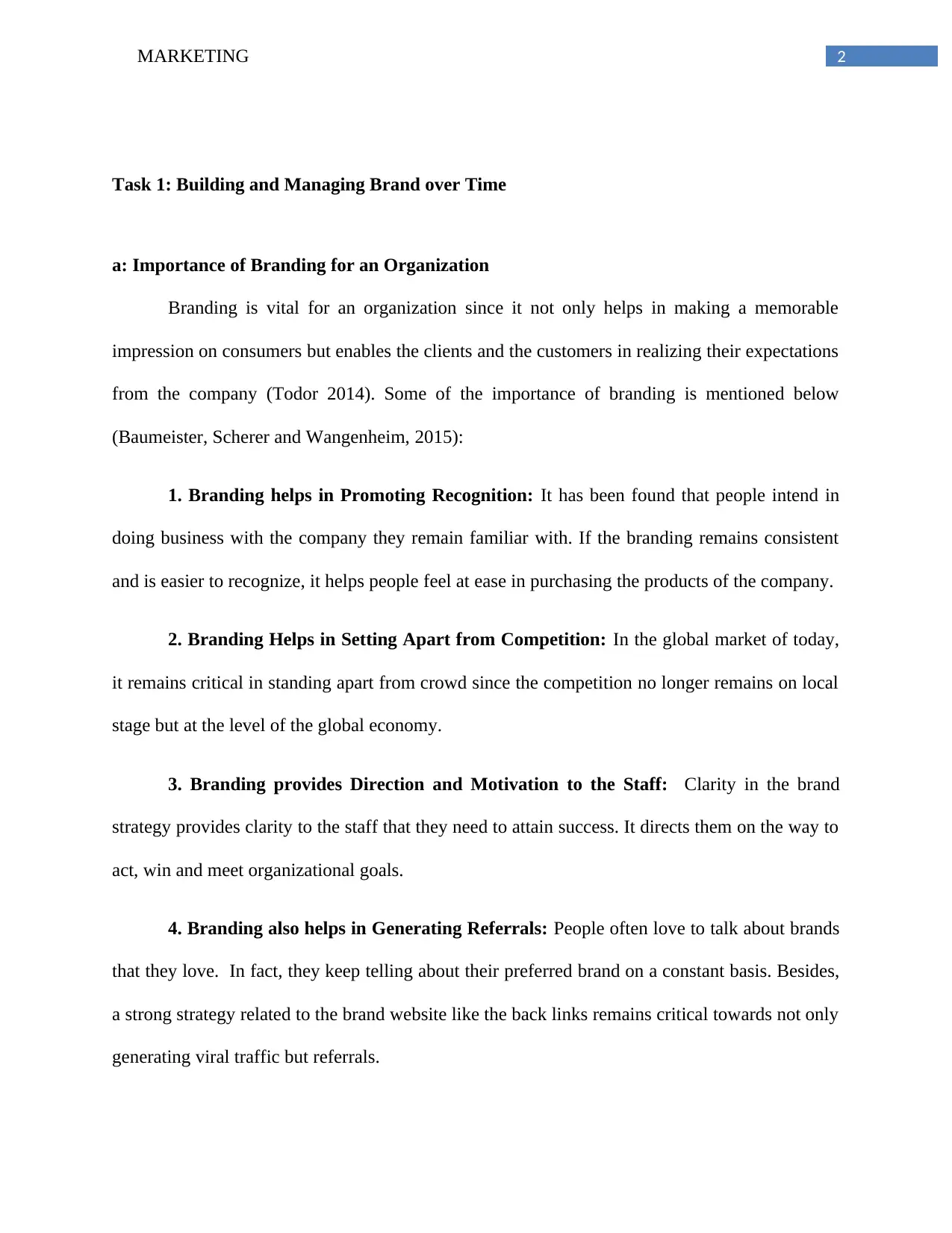
2MARKETING
Task 1: Building and Managing Brand over Time
a: Importance of Branding for an Organization
Branding is vital for an organization since it not only helps in making a memorable
impression on consumers but enables the clients and the customers in realizing their expectations
from the company (Todor 2014). Some of the importance of branding is mentioned below
(Baumeister, Scherer and Wangenheim, 2015):
1. Branding helps in Promoting Recognition: It has been found that people intend in
doing business with the company they remain familiar with. If the branding remains consistent
and is easier to recognize, it helps people feel at ease in purchasing the products of the company.
2. Branding Helps in Setting Apart from Competition: In the global market of today,
it remains critical in standing apart from crowd since the competition no longer remains on local
stage but at the level of the global economy.
3. Branding provides Direction and Motivation to the Staff: Clarity in the brand
strategy provides clarity to the staff that they need to attain success. It directs them on the way to
act, win and meet organizational goals.
4. Branding also helps in Generating Referrals: People often love to talk about brands
that they love. In fact, they keep telling about their preferred brand on a constant basis. Besides,
a strong strategy related to the brand website like the back links remains critical towards not only
generating viral traffic but referrals.
Task 1: Building and Managing Brand over Time
a: Importance of Branding for an Organization
Branding is vital for an organization since it not only helps in making a memorable
impression on consumers but enables the clients and the customers in realizing their expectations
from the company (Todor 2014). Some of the importance of branding is mentioned below
(Baumeister, Scherer and Wangenheim, 2015):
1. Branding helps in Promoting Recognition: It has been found that people intend in
doing business with the company they remain familiar with. If the branding remains consistent
and is easier to recognize, it helps people feel at ease in purchasing the products of the company.
2. Branding Helps in Setting Apart from Competition: In the global market of today,
it remains critical in standing apart from crowd since the competition no longer remains on local
stage but at the level of the global economy.
3. Branding provides Direction and Motivation to the Staff: Clarity in the brand
strategy provides clarity to the staff that they need to attain success. It directs them on the way to
act, win and meet organizational goals.
4. Branding also helps in Generating Referrals: People often love to talk about brands
that they love. In fact, they keep telling about their preferred brand on a constant basis. Besides,
a strong strategy related to the brand website like the back links remains critical towards not only
generating viral traffic but referrals.
⊘ This is a preview!⊘
Do you want full access?
Subscribe today to unlock all pages.

Trusted by 1+ million students worldwide
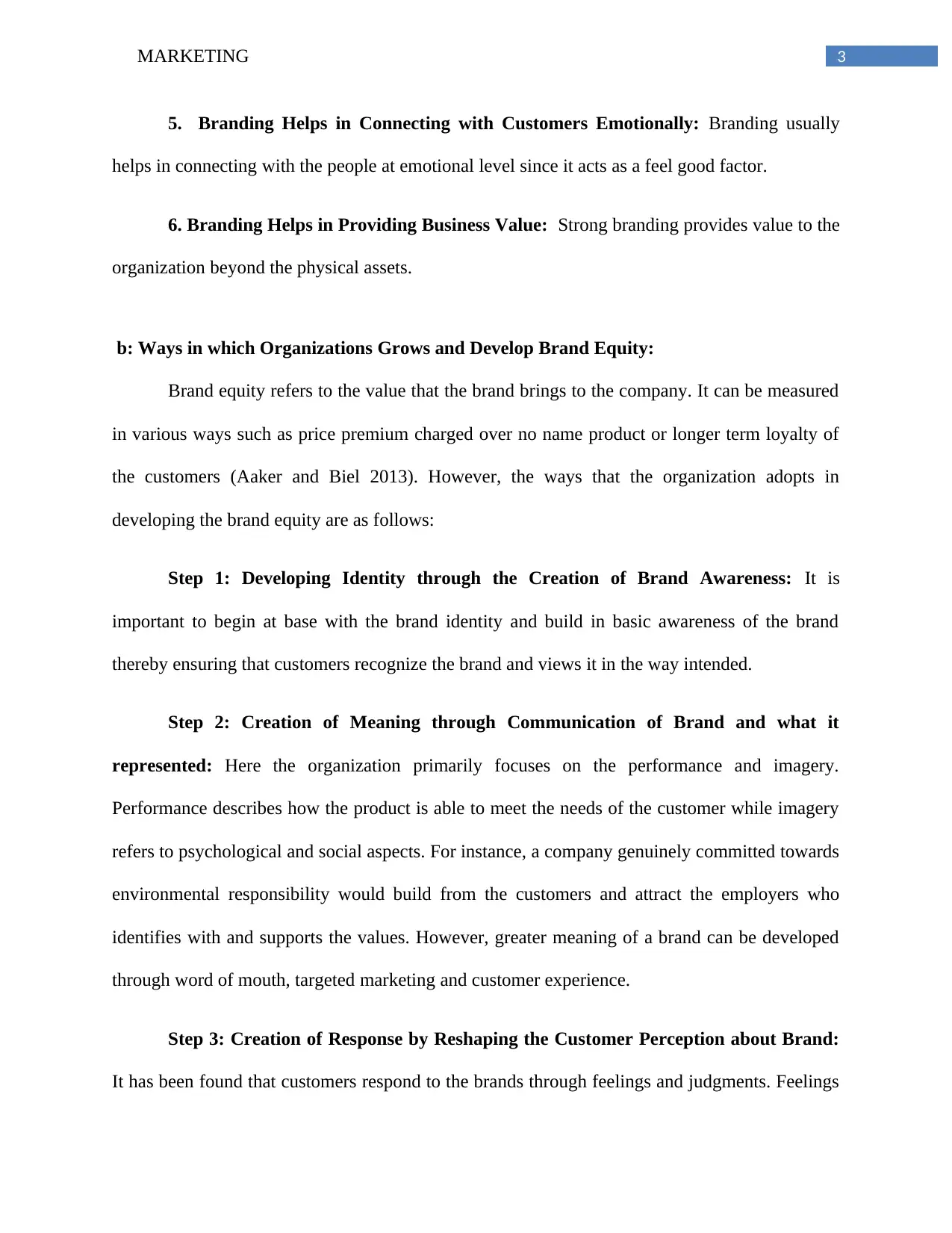
3MARKETING
5. Branding Helps in Connecting with Customers Emotionally: Branding usually
helps in connecting with the people at emotional level since it acts as a feel good factor.
6. Branding Helps in Providing Business Value: Strong branding provides value to the
organization beyond the physical assets.
b: Ways in which Organizations Grows and Develop Brand Equity:
Brand equity refers to the value that the brand brings to the company. It can be measured
in various ways such as price premium charged over no name product or longer term loyalty of
the customers (Aaker and Biel 2013). However, the ways that the organization adopts in
developing the brand equity are as follows:
Step 1: Developing Identity through the Creation of Brand Awareness: It is
important to begin at base with the brand identity and build in basic awareness of the brand
thereby ensuring that customers recognize the brand and views it in the way intended.
Step 2: Creation of Meaning through Communication of Brand and what it
represented: Here the organization primarily focuses on the performance and imagery.
Performance describes how the product is able to meet the needs of the customer while imagery
refers to psychological and social aspects. For instance, a company genuinely committed towards
environmental responsibility would build from the customers and attract the employers who
identifies with and supports the values. However, greater meaning of a brand can be developed
through word of mouth, targeted marketing and customer experience.
Step 3: Creation of Response by Reshaping the Customer Perception about Brand:
It has been found that customers respond to the brands through feelings and judgments. Feelings
5. Branding Helps in Connecting with Customers Emotionally: Branding usually
helps in connecting with the people at emotional level since it acts as a feel good factor.
6. Branding Helps in Providing Business Value: Strong branding provides value to the
organization beyond the physical assets.
b: Ways in which Organizations Grows and Develop Brand Equity:
Brand equity refers to the value that the brand brings to the company. It can be measured
in various ways such as price premium charged over no name product or longer term loyalty of
the customers (Aaker and Biel 2013). However, the ways that the organization adopts in
developing the brand equity are as follows:
Step 1: Developing Identity through the Creation of Brand Awareness: It is
important to begin at base with the brand identity and build in basic awareness of the brand
thereby ensuring that customers recognize the brand and views it in the way intended.
Step 2: Creation of Meaning through Communication of Brand and what it
represented: Here the organization primarily focuses on the performance and imagery.
Performance describes how the product is able to meet the needs of the customer while imagery
refers to psychological and social aspects. For instance, a company genuinely committed towards
environmental responsibility would build from the customers and attract the employers who
identifies with and supports the values. However, greater meaning of a brand can be developed
through word of mouth, targeted marketing and customer experience.
Step 3: Creation of Response by Reshaping the Customer Perception about Brand:
It has been found that customers respond to the brands through feelings and judgments. Feelings
Paraphrase This Document
Need a fresh take? Get an instant paraphrase of this document with our AI Paraphraser
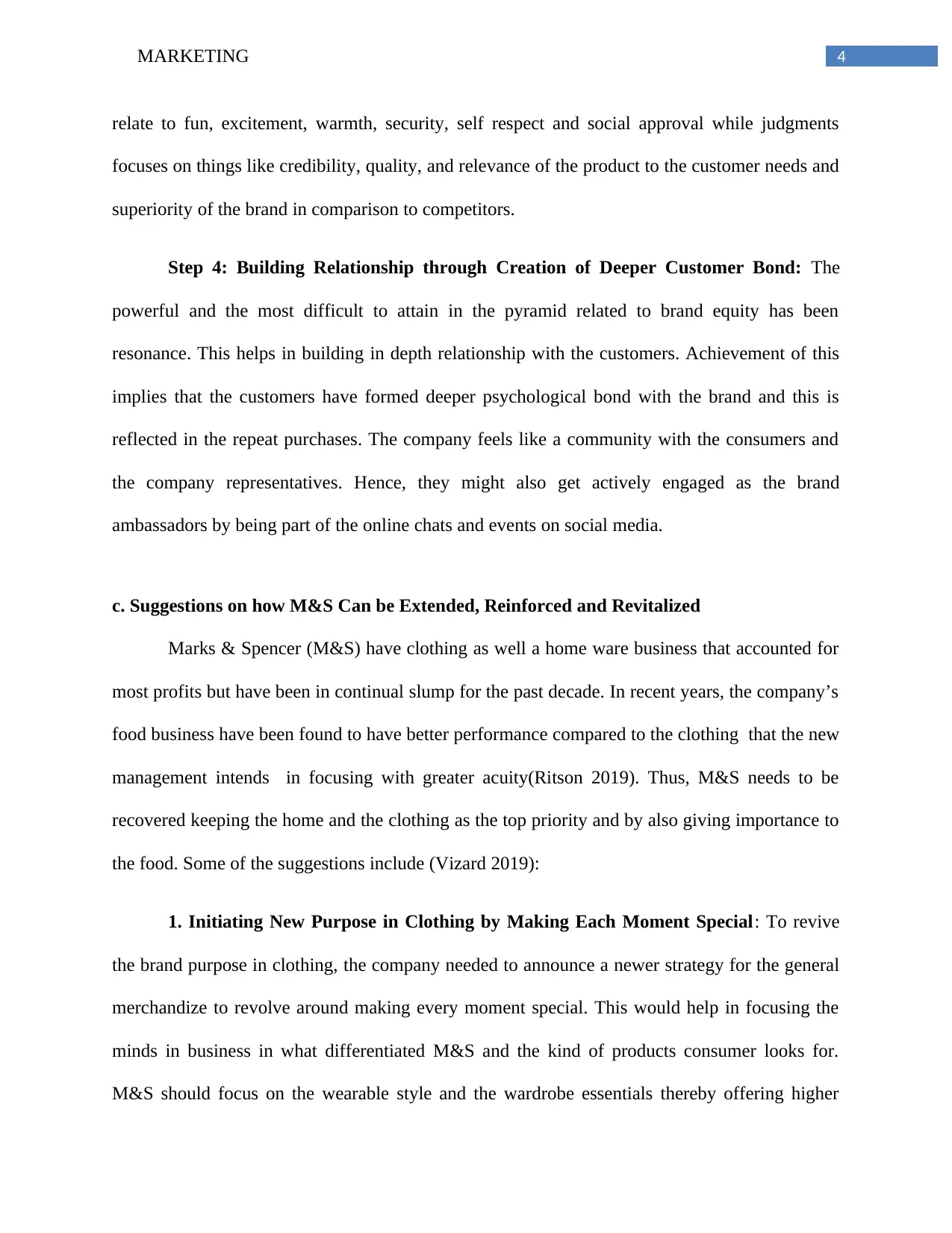
4MARKETING
relate to fun, excitement, warmth, security, self respect and social approval while judgments
focuses on things like credibility, quality, and relevance of the product to the customer needs and
superiority of the brand in comparison to competitors.
Step 4: Building Relationship through Creation of Deeper Customer Bond: The
powerful and the most difficult to attain in the pyramid related to brand equity has been
resonance. This helps in building in depth relationship with the customers. Achievement of this
implies that the customers have formed deeper psychological bond with the brand and this is
reflected in the repeat purchases. The company feels like a community with the consumers and
the company representatives. Hence, they might also get actively engaged as the brand
ambassadors by being part of the online chats and events on social media.
c. Suggestions on how M&S Can be Extended, Reinforced and Revitalized
Marks & Spencer (M&S) have clothing as well a home ware business that accounted for
most profits but have been in continual slump for the past decade. In recent years, the company’s
food business have been found to have better performance compared to the clothing that the new
management intends in focusing with greater acuity(Ritson 2019). Thus, M&S needs to be
recovered keeping the home and the clothing as the top priority and by also giving importance to
the food. Some of the suggestions include (Vizard 2019):
1. Initiating New Purpose in Clothing by Making Each Moment Special: To revive
the brand purpose in clothing, the company needed to announce a newer strategy for the general
merchandize to revolve around making every moment special. This would help in focusing the
minds in business in what differentiated M&S and the kind of products consumer looks for.
M&S should focus on the wearable style and the wardrobe essentials thereby offering higher
relate to fun, excitement, warmth, security, self respect and social approval while judgments
focuses on things like credibility, quality, and relevance of the product to the customer needs and
superiority of the brand in comparison to competitors.
Step 4: Building Relationship through Creation of Deeper Customer Bond: The
powerful and the most difficult to attain in the pyramid related to brand equity has been
resonance. This helps in building in depth relationship with the customers. Achievement of this
implies that the customers have formed deeper psychological bond with the brand and this is
reflected in the repeat purchases. The company feels like a community with the consumers and
the company representatives. Hence, they might also get actively engaged as the brand
ambassadors by being part of the online chats and events on social media.
c. Suggestions on how M&S Can be Extended, Reinforced and Revitalized
Marks & Spencer (M&S) have clothing as well a home ware business that accounted for
most profits but have been in continual slump for the past decade. In recent years, the company’s
food business have been found to have better performance compared to the clothing that the new
management intends in focusing with greater acuity(Ritson 2019). Thus, M&S needs to be
recovered keeping the home and the clothing as the top priority and by also giving importance to
the food. Some of the suggestions include (Vizard 2019):
1. Initiating New Purpose in Clothing by Making Each Moment Special: To revive
the brand purpose in clothing, the company needed to announce a newer strategy for the general
merchandize to revolve around making every moment special. This would help in focusing the
minds in business in what differentiated M&S and the kind of products consumer looks for.
M&S should focus on the wearable style and the wardrobe essentials thereby offering higher
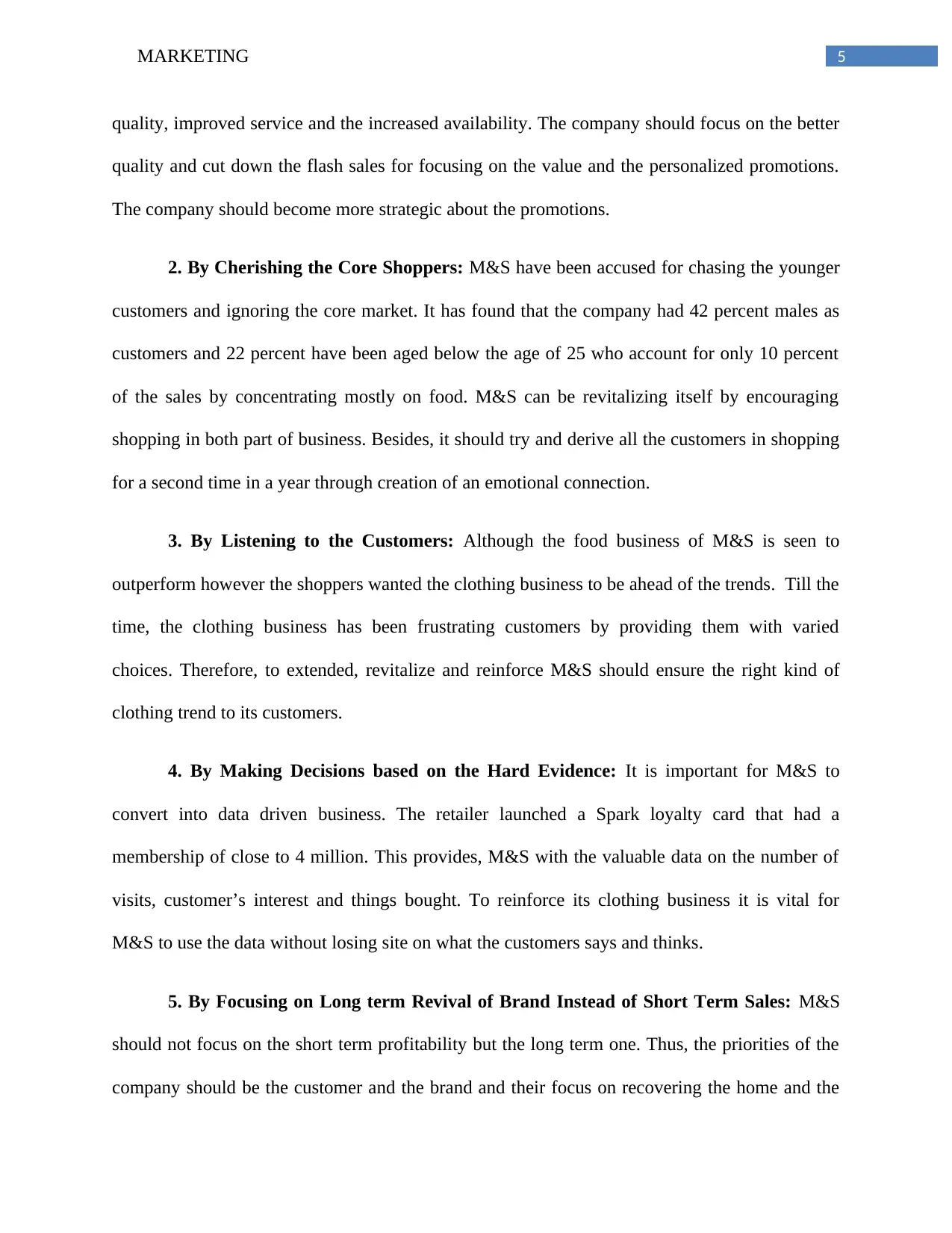
5MARKETING
quality, improved service and the increased availability. The company should focus on the better
quality and cut down the flash sales for focusing on the value and the personalized promotions.
The company should become more strategic about the promotions.
2. By Cherishing the Core Shoppers: M&S have been accused for chasing the younger
customers and ignoring the core market. It has found that the company had 42 percent males as
customers and 22 percent have been aged below the age of 25 who account for only 10 percent
of the sales by concentrating mostly on food. M&S can be revitalizing itself by encouraging
shopping in both part of business. Besides, it should try and derive all the customers in shopping
for a second time in a year through creation of an emotional connection.
3. By Listening to the Customers: Although the food business of M&S is seen to
outperform however the shoppers wanted the clothing business to be ahead of the trends. Till the
time, the clothing business has been frustrating customers by providing them with varied
choices. Therefore, to extended, revitalize and reinforce M&S should ensure the right kind of
clothing trend to its customers.
4. By Making Decisions based on the Hard Evidence: It is important for M&S to
convert into data driven business. The retailer launched a Spark loyalty card that had a
membership of close to 4 million. This provides, M&S with the valuable data on the number of
visits, customer’s interest and things bought. To reinforce its clothing business it is vital for
M&S to use the data without losing site on what the customers says and thinks.
5. By Focusing on Long term Revival of Brand Instead of Short Term Sales: M&S
should not focus on the short term profitability but the long term one. Thus, the priorities of the
company should be the customer and the brand and their focus on recovering the home and the
quality, improved service and the increased availability. The company should focus on the better
quality and cut down the flash sales for focusing on the value and the personalized promotions.
The company should become more strategic about the promotions.
2. By Cherishing the Core Shoppers: M&S have been accused for chasing the younger
customers and ignoring the core market. It has found that the company had 42 percent males as
customers and 22 percent have been aged below the age of 25 who account for only 10 percent
of the sales by concentrating mostly on food. M&S can be revitalizing itself by encouraging
shopping in both part of business. Besides, it should try and derive all the customers in shopping
for a second time in a year through creation of an emotional connection.
3. By Listening to the Customers: Although the food business of M&S is seen to
outperform however the shoppers wanted the clothing business to be ahead of the trends. Till the
time, the clothing business has been frustrating customers by providing them with varied
choices. Therefore, to extended, revitalize and reinforce M&S should ensure the right kind of
clothing trend to its customers.
4. By Making Decisions based on the Hard Evidence: It is important for M&S to
convert into data driven business. The retailer launched a Spark loyalty card that had a
membership of close to 4 million. This provides, M&S with the valuable data on the number of
visits, customer’s interest and things bought. To reinforce its clothing business it is vital for
M&S to use the data without losing site on what the customers says and thinks.
5. By Focusing on Long term Revival of Brand Instead of Short Term Sales: M&S
should not focus on the short term profitability but the long term one. Thus, the priorities of the
company should be the customer and the brand and their focus on recovering the home and the
⊘ This is a preview!⊘
Do you want full access?
Subscribe today to unlock all pages.

Trusted by 1+ million students worldwide
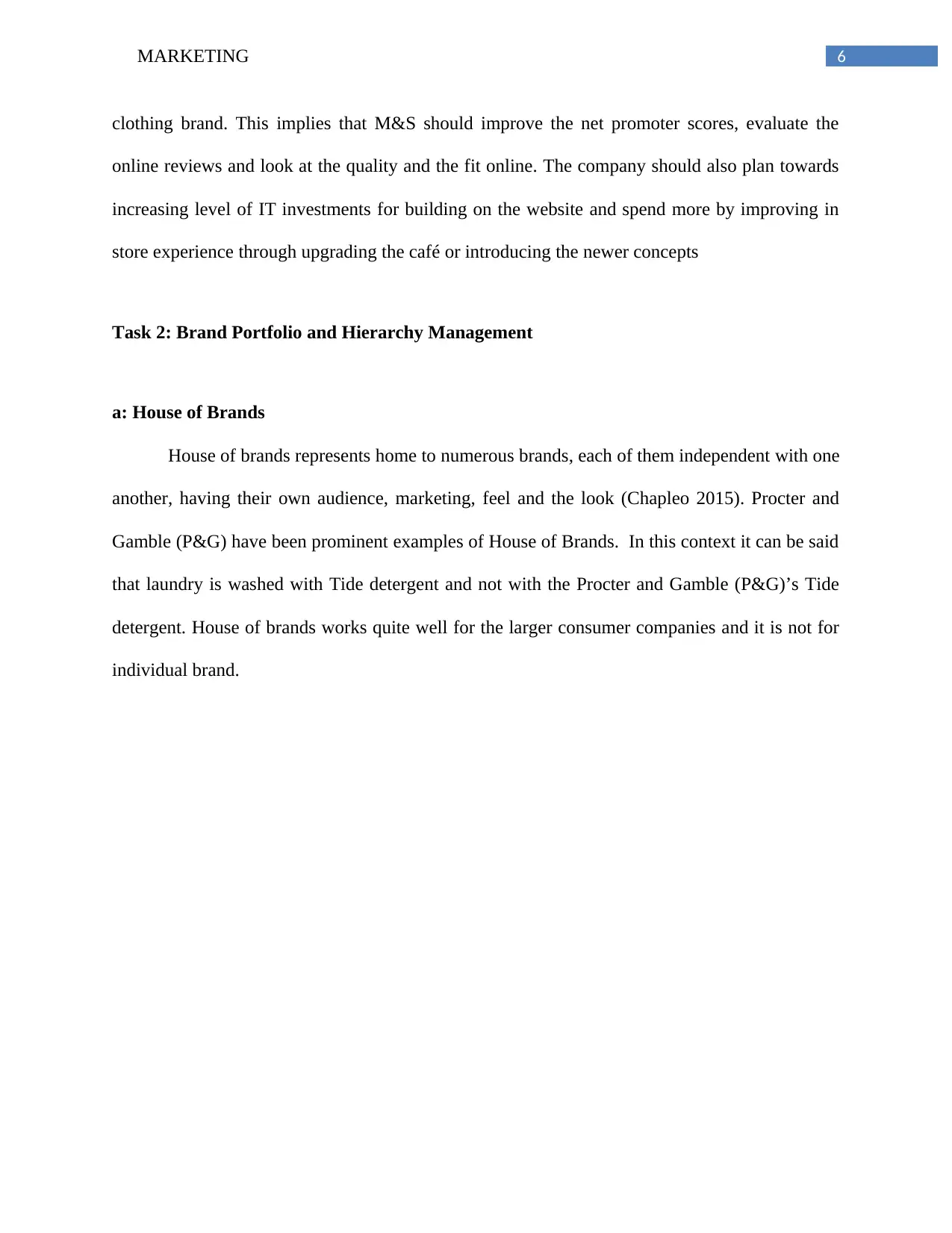
6MARKETING
clothing brand. This implies that M&S should improve the net promoter scores, evaluate the
online reviews and look at the quality and the fit online. The company should also plan towards
increasing level of IT investments for building on the website and spend more by improving in
store experience through upgrading the café or introducing the newer concepts
Task 2: Brand Portfolio and Hierarchy Management
a: House of Brands
House of brands represents home to numerous brands, each of them independent with one
another, having their own audience, marketing, feel and the look (Chapleo 2015). Procter and
Gamble (P&G) have been prominent examples of House of Brands. In this context it can be said
that laundry is washed with Tide detergent and not with the Procter and Gamble (P&G)’s Tide
detergent. House of brands works quite well for the larger consumer companies and it is not for
individual brand.
clothing brand. This implies that M&S should improve the net promoter scores, evaluate the
online reviews and look at the quality and the fit online. The company should also plan towards
increasing level of IT investments for building on the website and spend more by improving in
store experience through upgrading the café or introducing the newer concepts
Task 2: Brand Portfolio and Hierarchy Management
a: House of Brands
House of brands represents home to numerous brands, each of them independent with one
another, having their own audience, marketing, feel and the look (Chapleo 2015). Procter and
Gamble (P&G) have been prominent examples of House of Brands. In this context it can be said
that laundry is washed with Tide detergent and not with the Procter and Gamble (P&G)’s Tide
detergent. House of brands works quite well for the larger consumer companies and it is not for
individual brand.
Paraphrase This Document
Need a fresh take? Get an instant paraphrase of this document with our AI Paraphraser
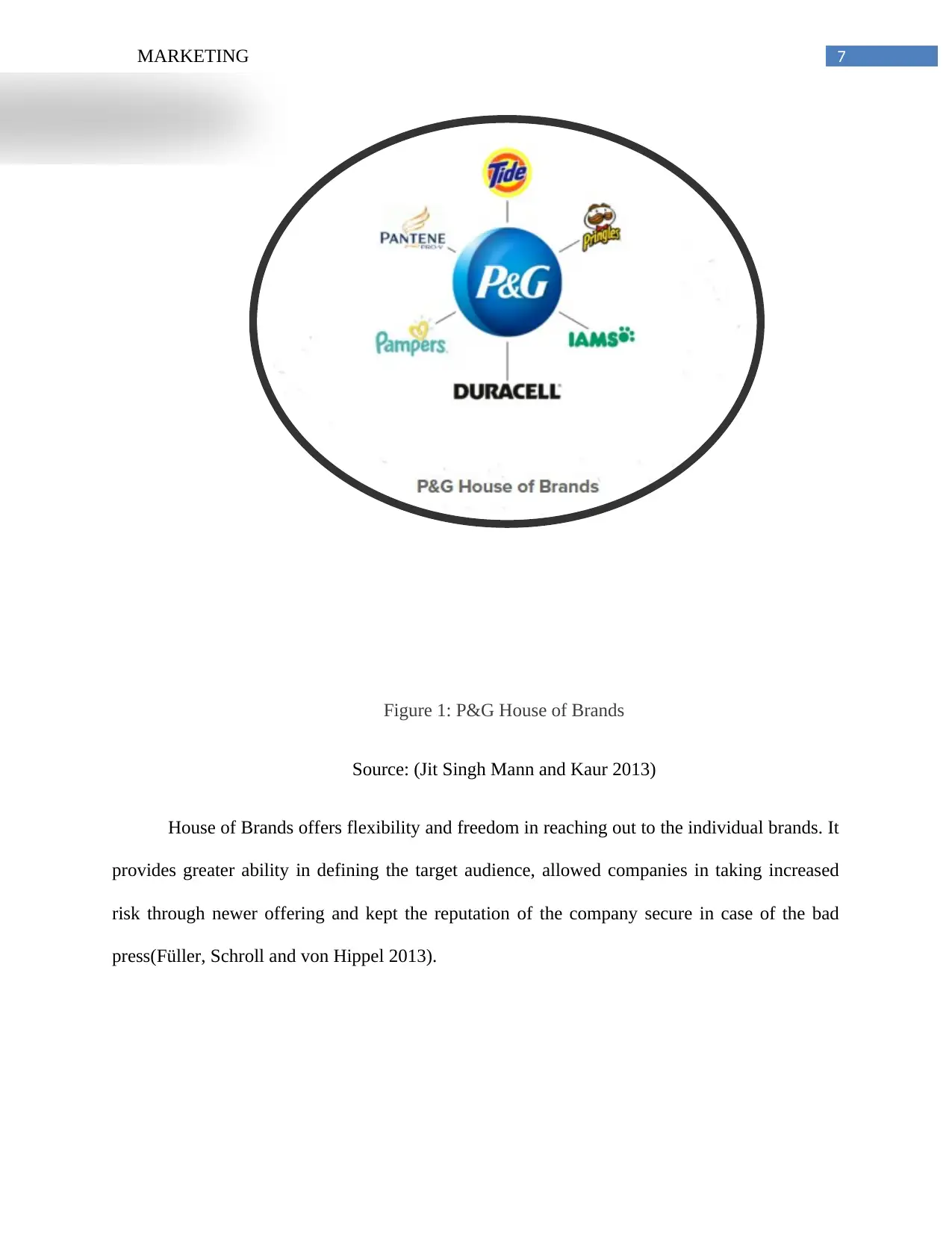
7MARKETING
Figure 1: P&G House of Brands
Source: (Jit Singh Mann and Kaur 2013)
House of Brands offers flexibility and freedom in reaching out to the individual brands. It
provides greater ability in defining the target audience, allowed companies in taking increased
risk through newer offering and kept the reputation of the company secure in case of the bad
press(Füller, Schroll and von Hippel 2013).
Figure 1: P&G House of Brands
Source: (Jit Singh Mann and Kaur 2013)
House of Brands offers flexibility and freedom in reaching out to the individual brands. It
provides greater ability in defining the target audience, allowed companies in taking increased
risk through newer offering and kept the reputation of the company secure in case of the bad
press(Füller, Schroll and von Hippel 2013).
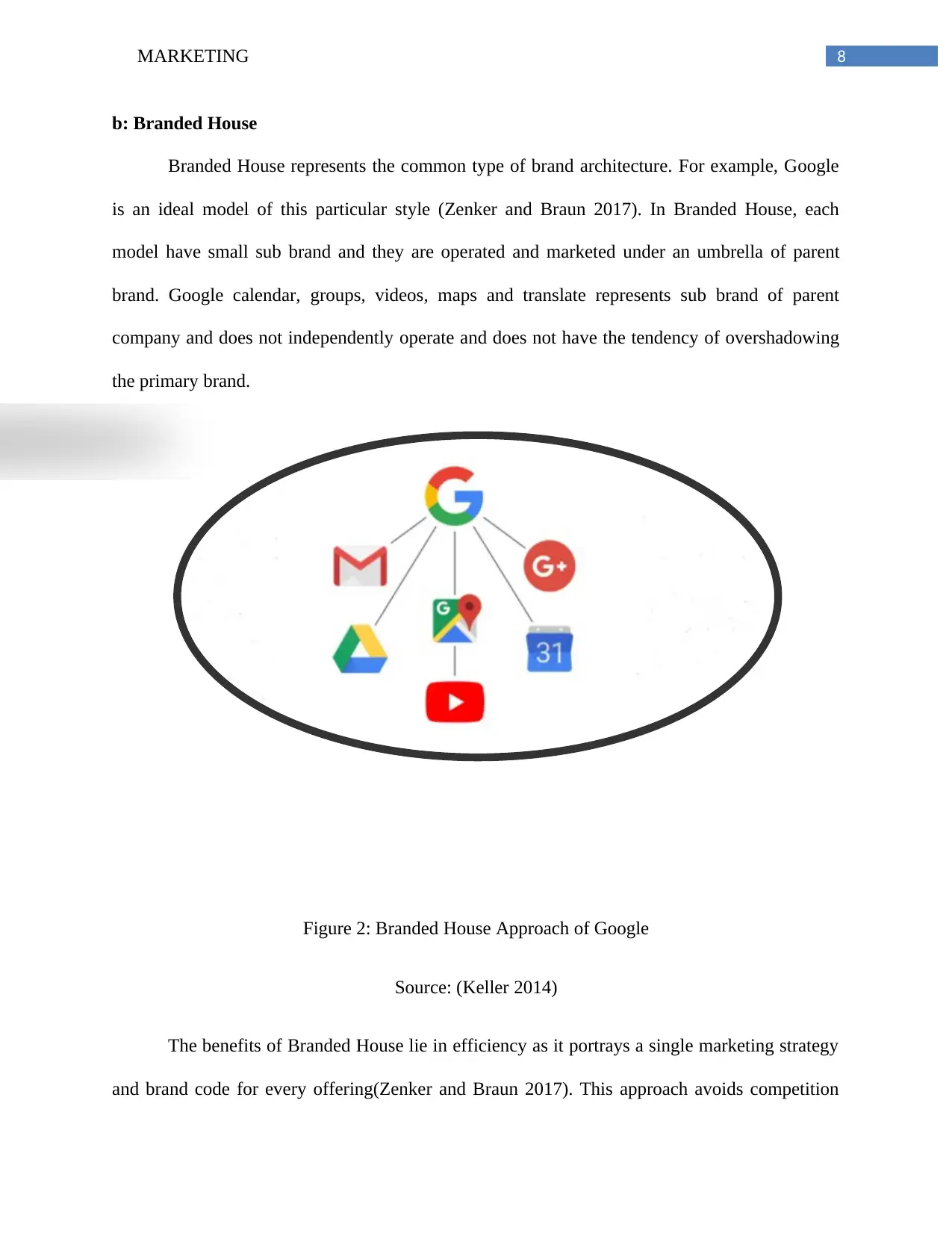
8MARKETING
b: Branded House
Branded House represents the common type of brand architecture. For example, Google
is an ideal model of this particular style (Zenker and Braun 2017). In Branded House, each
model have small sub brand and they are operated and marketed under an umbrella of parent
brand. Google calendar, groups, videos, maps and translate represents sub brand of parent
company and does not independently operate and does not have the tendency of overshadowing
the primary brand.
Figure 2: Branded House Approach of Google
Source: (Keller 2014)
The benefits of Branded House lie in efficiency as it portrays a single marketing strategy
and brand code for every offering(Zenker and Braun 2017). This approach avoids competition
b: Branded House
Branded House represents the common type of brand architecture. For example, Google
is an ideal model of this particular style (Zenker and Braun 2017). In Branded House, each
model have small sub brand and they are operated and marketed under an umbrella of parent
brand. Google calendar, groups, videos, maps and translate represents sub brand of parent
company and does not independently operate and does not have the tendency of overshadowing
the primary brand.
Figure 2: Branded House Approach of Google
Source: (Keller 2014)
The benefits of Branded House lie in efficiency as it portrays a single marketing strategy
and brand code for every offering(Zenker and Braun 2017). This approach avoids competition
⊘ This is a preview!⊘
Do you want full access?
Subscribe today to unlock all pages.

Trusted by 1+ million students worldwide
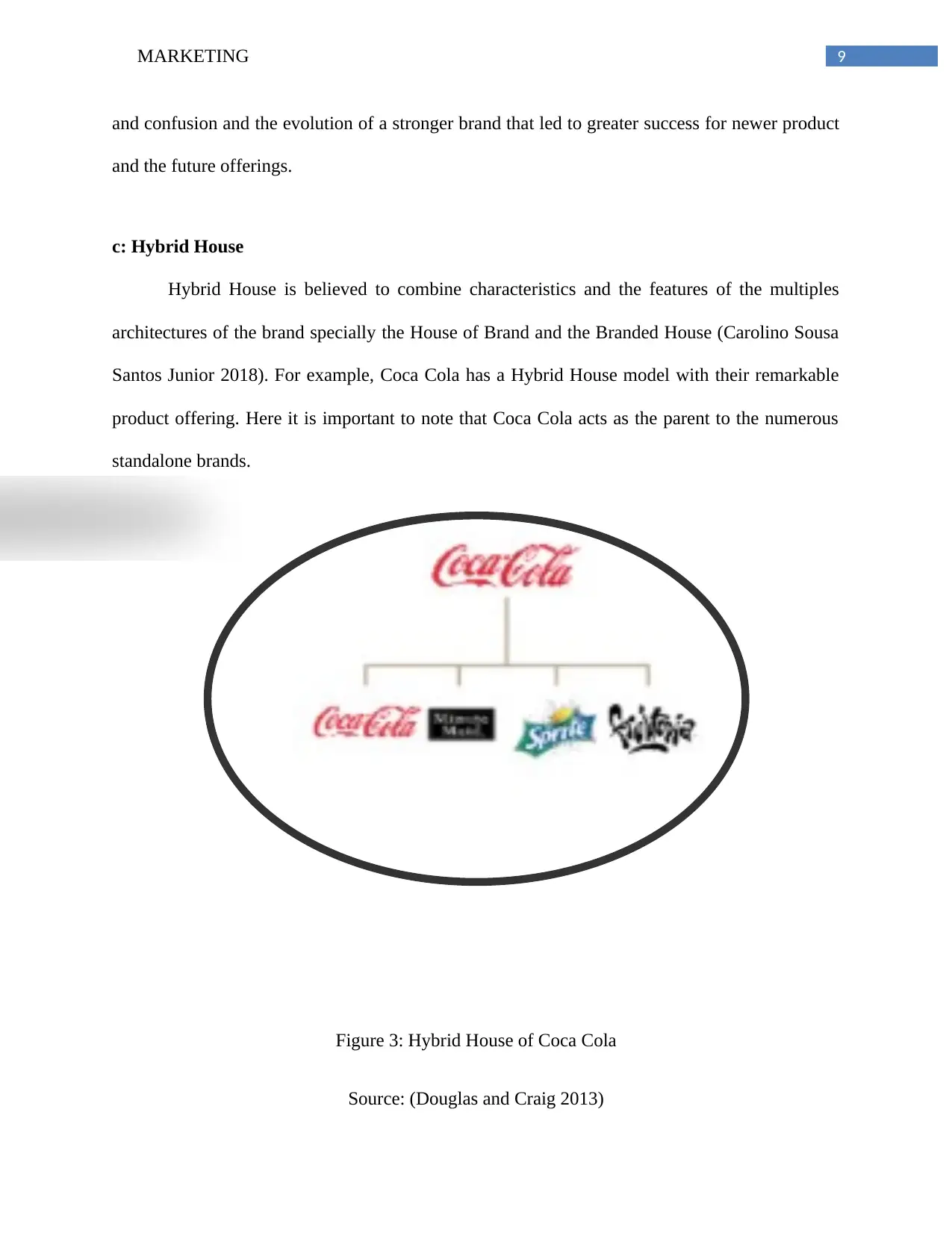
9MARKETING
and confusion and the evolution of a stronger brand that led to greater success for newer product
and the future offerings.
c: Hybrid House
Hybrid House is believed to combine characteristics and the features of the multiples
architectures of the brand specially the House of Brand and the Branded House (Carolino Sousa
Santos Junior 2018). For example, Coca Cola has a Hybrid House model with their remarkable
product offering. Here it is important to note that Coca Cola acts as the parent to the numerous
standalone brands.
Figure 3: Hybrid House of Coca Cola
Source: (Douglas and Craig 2013)
and confusion and the evolution of a stronger brand that led to greater success for newer product
and the future offerings.
c: Hybrid House
Hybrid House is believed to combine characteristics and the features of the multiples
architectures of the brand specially the House of Brand and the Branded House (Carolino Sousa
Santos Junior 2018). For example, Coca Cola has a Hybrid House model with their remarkable
product offering. Here it is important to note that Coca Cola acts as the parent to the numerous
standalone brands.
Figure 3: Hybrid House of Coca Cola
Source: (Douglas and Craig 2013)
Paraphrase This Document
Need a fresh take? Get an instant paraphrase of this document with our AI Paraphraser
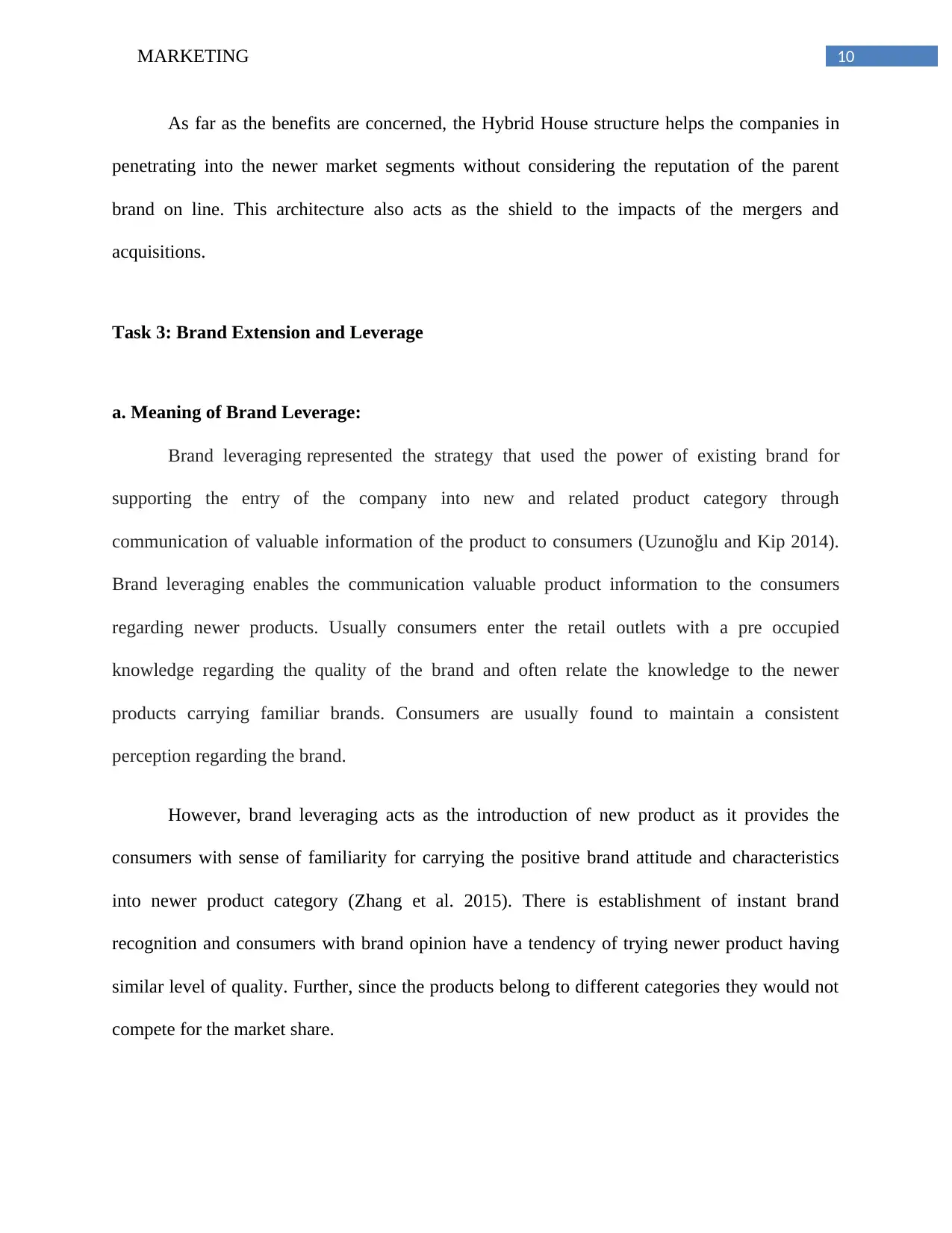
10MARKETING
As far as the benefits are concerned, the Hybrid House structure helps the companies in
penetrating into the newer market segments without considering the reputation of the parent
brand on line. This architecture also acts as the shield to the impacts of the mergers and
acquisitions.
Task 3: Brand Extension and Leverage
a. Meaning of Brand Leverage:
Brand leveraging represented the strategy that used the power of existing brand for
supporting the entry of the company into new and related product category through
communication of valuable information of the product to consumers (Uzunoğlu and Kip 2014).
Brand leveraging enables the communication valuable product information to the consumers
regarding newer products. Usually consumers enter the retail outlets with a pre occupied
knowledge regarding the quality of the brand and often relate the knowledge to the newer
products carrying familiar brands. Consumers are usually found to maintain a consistent
perception regarding the brand.
However, brand leveraging acts as the introduction of new product as it provides the
consumers with sense of familiarity for carrying the positive brand attitude and characteristics
into newer product category (Zhang et al. 2015). There is establishment of instant brand
recognition and consumers with brand opinion have a tendency of trying newer product having
similar level of quality. Further, since the products belong to different categories they would not
compete for the market share.
As far as the benefits are concerned, the Hybrid House structure helps the companies in
penetrating into the newer market segments without considering the reputation of the parent
brand on line. This architecture also acts as the shield to the impacts of the mergers and
acquisitions.
Task 3: Brand Extension and Leverage
a. Meaning of Brand Leverage:
Brand leveraging represented the strategy that used the power of existing brand for
supporting the entry of the company into new and related product category through
communication of valuable information of the product to consumers (Uzunoğlu and Kip 2014).
Brand leveraging enables the communication valuable product information to the consumers
regarding newer products. Usually consumers enter the retail outlets with a pre occupied
knowledge regarding the quality of the brand and often relate the knowledge to the newer
products carrying familiar brands. Consumers are usually found to maintain a consistent
perception regarding the brand.
However, brand leveraging acts as the introduction of new product as it provides the
consumers with sense of familiarity for carrying the positive brand attitude and characteristics
into newer product category (Zhang et al. 2015). There is establishment of instant brand
recognition and consumers with brand opinion have a tendency of trying newer product having
similar level of quality. Further, since the products belong to different categories they would not
compete for the market share.
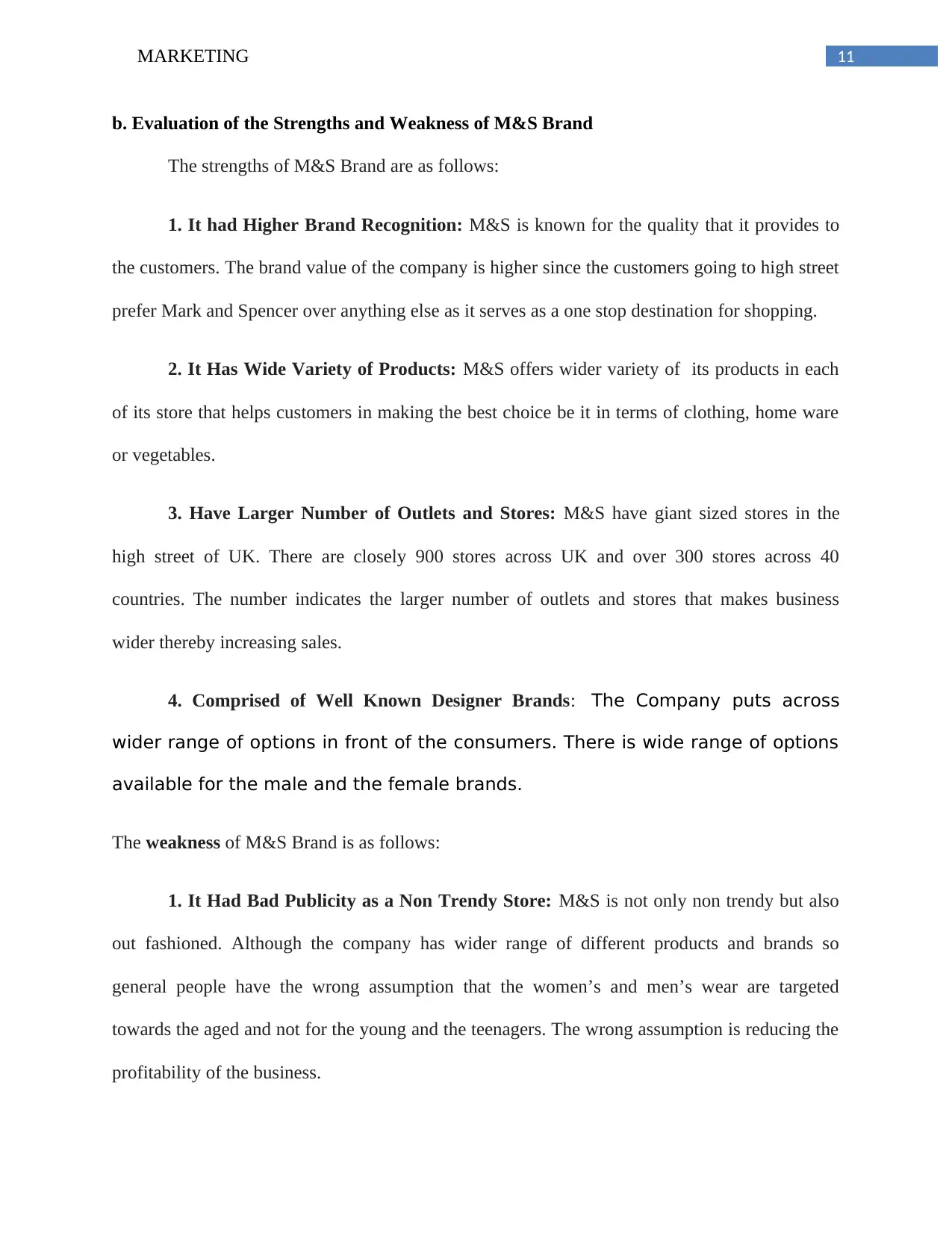
11MARKETING
b. Evaluation of the Strengths and Weakness of M&S Brand
The strengths of M&S Brand are as follows:
1. It had Higher Brand Recognition: M&S is known for the quality that it provides to
the customers. The brand value of the company is higher since the customers going to high street
prefer Mark and Spencer over anything else as it serves as a one stop destination for shopping.
2. It Has Wide Variety of Products: M&S offers wider variety of its products in each
of its store that helps customers in making the best choice be it in terms of clothing, home ware
or vegetables.
3. Have Larger Number of Outlets and Stores: M&S have giant sized stores in the
high street of UK. There are closely 900 stores across UK and over 300 stores across 40
countries. The number indicates the larger number of outlets and stores that makes business
wider thereby increasing sales.
4. Comprised of Well Known Designer Brands: The Company puts across
wider range of options in front of the consumers. There is wide range of options
available for the male and the female brands.
The weakness of M&S Brand is as follows:
1. It Had Bad Publicity as a Non Trendy Store: M&S is not only non trendy but also
out fashioned. Although the company has wider range of different products and brands so
general people have the wrong assumption that the women’s and men’s wear are targeted
towards the aged and not for the young and the teenagers. The wrong assumption is reducing the
profitability of the business.
b. Evaluation of the Strengths and Weakness of M&S Brand
The strengths of M&S Brand are as follows:
1. It had Higher Brand Recognition: M&S is known for the quality that it provides to
the customers. The brand value of the company is higher since the customers going to high street
prefer Mark and Spencer over anything else as it serves as a one stop destination for shopping.
2. It Has Wide Variety of Products: M&S offers wider variety of its products in each
of its store that helps customers in making the best choice be it in terms of clothing, home ware
or vegetables.
3. Have Larger Number of Outlets and Stores: M&S have giant sized stores in the
high street of UK. There are closely 900 stores across UK and over 300 stores across 40
countries. The number indicates the larger number of outlets and stores that makes business
wider thereby increasing sales.
4. Comprised of Well Known Designer Brands: The Company puts across
wider range of options in front of the consumers. There is wide range of options
available for the male and the female brands.
The weakness of M&S Brand is as follows:
1. It Had Bad Publicity as a Non Trendy Store: M&S is not only non trendy but also
out fashioned. Although the company has wider range of different products and brands so
general people have the wrong assumption that the women’s and men’s wear are targeted
towards the aged and not for the young and the teenagers. The wrong assumption is reducing the
profitability of the business.
⊘ This is a preview!⊘
Do you want full access?
Subscribe today to unlock all pages.

Trusted by 1+ million students worldwide
1 out of 18
Related Documents
Your All-in-One AI-Powered Toolkit for Academic Success.
+13062052269
info@desklib.com
Available 24*7 on WhatsApp / Email
![[object Object]](/_next/static/media/star-bottom.7253800d.svg)
Unlock your academic potential
Copyright © 2020–2025 A2Z Services. All Rights Reserved. Developed and managed by ZUCOL.




